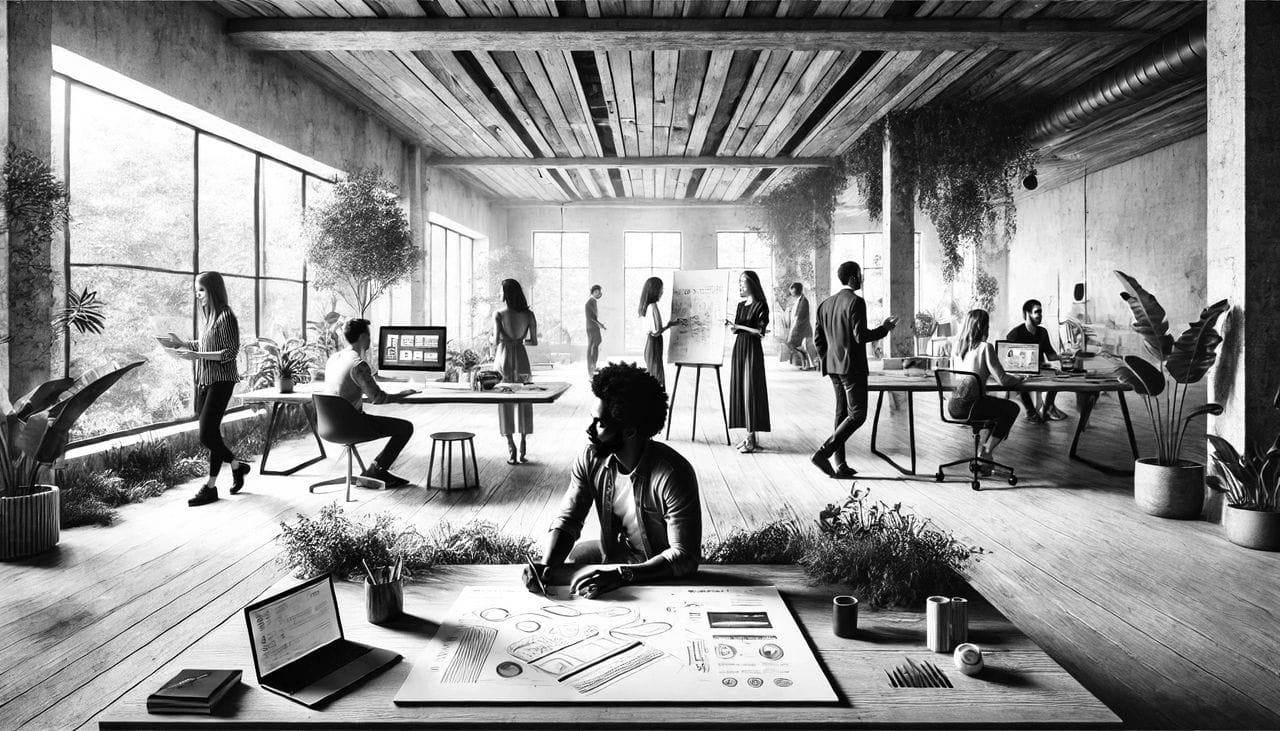Neo-Natural and Human-Centric Innovation: Integrating AI to Improve Sustainable Architectural and Community Design

As climate change continues to escalate the frequency and intensity of natural disasters, the need for sustainable and resilient architectural and community design has never been more pressing. Recent imagery of the devastation wrought by hurricanes Helene and Milton in Naples, Florida, serves as a stark reminder of how vulnerable our built environments can be when faced with the overwhelming power of nature. In response, a forward-thinking approach that blends neo-naturalist philosophy with human-centric design, bolstered by AI-driven innovations, can offer a path toward more sustainable and resilient communities.
Understanding Neo-Naturalism in Architecture and Human-Centric Design

Neo-naturalism is a design philosophy that emphasizes a harmonious relationship between human-built environments and the natural world. It encourages the integration of natural elements and processes into architectural design, creating spaces that adapt to and coexist with nature. As opposed to traditional methods that often treat nature as something to be controlled or fought against, neo-naturalism views natural forces as an integral part of the design process.
The fallen palm trees strewn across the beach, their roots exposed, provide a direct visual reminder of how vulnerable natural systems can be when subjected to overwhelming forces. Yet, some palms remain upright, demonstrating the potential for resilience when built structures and natural elements work in synergy. In architecture, we can mimic this balance by incorporating natural flexibility and adaptability into design, ensuring that buildings bend rather than break under environmental stress.
For instance, adopting biomimicry in hurricane-prone areas can lead to the use of materials and structures that emulate the bending flexibility of these palm trees. AI can assist in modeling how such materials will respond to different environmental forces, ensuring buildings can withstand similar pressures while maintaining their integrity.
Neo-Naturalism design philosophy and perspective is crucial when considering how our communities interact with their surroundings. Buildings designed under neo-naturalist principles are not only aesthetically pleasing but are also more resilient to environmental changes. In the face of extreme weather patterns, neo-naturalist architecture leverages biomimicry—taking inspiration from natural systems to solve design challenges. For instance, just as trees bend and sway in the wind to avoid breaking, flexible, wind-resistant materials can be incorporated into architectural designs to enhance their durability during hurricanes or storms.
Human-centric design, which prioritizes the well-being and safety of people, further enhances this by ensuring that the built environment protects and nurtures its inhabitants, especially in the face of climate disruptions. The devastation depicted in the aftermath of hurricanes underscores the need for actionable steps that address both the ecological and human aspects of design
Human-Centric Design: Prioritizing Sustainability and Resilience
Human-centric design is a complementary approach that places the needs, safety, and well-being of people at the center of the design process. When applied to sustainable architecture, this philosophy ensures that the built environment is not only ecologically responsible but also enhances the quality of life for its occupants.

The desolate beach, now devoid of human activity, hints at the displacement that often follows natural disasters. Communities affected by hurricanes face both immediate dangers and long-term challenges in rebuilding their homes and infrastructure. AI-driven urban planning can anticipate such disruptions and design communities with the flexibility to adapt to sudden environmental changes.
For example, predictive models powered by AI can optimize evacuation routes and plan for emergency shelters in coastal cities like Naples, where hurricanes are a recurring threat. This kind of design anticipates the human need for safety and quick recovery, ensuring communities remain functional even in the face of disaster.
In the context of community design, human-centric principles can manifest in various ways—from the inclusion of ample green spaces that support mental health and well-being, to designing efficient and accessible evacuation routes for residents during emergencies. As natural disasters become more frequent, creating spaces that protect and nurture their inhabitants is paramount.
The Role of AI in Advancing Sustainable Design
Artificial Intelligence (AI) offers powerful tools to revolutionize both neo-naturalist and human-centric design approaches. By harnessing AI-driven technologies, architects, urban planners, and developers can craft environments that are smarter, more adaptive, and responsive to both human needs and natural forces.
Here are some key areas where AI can drive innovation in sustainable design:
1. Predictive Environmental Modeling:
AI can analyze vast amounts of environmental data, including weather patterns, flood risks, and climate projections, to help architects and city planners anticipate and adapt to environmental challenges. By simulating the long-term impact of climate change on specific regions, AI can inform design choices that improve the resilience of buildings and infrastructure. For example, structures in hurricane-prone areas can be designed with AI-informed materials and layouts to withstand high winds and storm surges.

The scattered debris and fallen trees in the image above highlights the need for infrastructure capable of withstanding powerful storms. AI could simulate how similar forces will impact newly designed buildings and public spaces in the future. For example, it could analyze wind patterns and recommend materials that mimic the flexibility of the surviving palm trees, ensuring that new structures can endure without collapsing.
2. Energy Efficiency and Smart Grids:
One of AI’s most transformative applications is in optimizing energy use. Smart systems powered by AI can monitor and adjust energy consumption in real-time, reducing waste and lowering carbon footprints. Buildings can be equipped with sensors that track energy usage patterns and adjust heating, cooling, and lighting systems accordingly, ensuring that no energy is wasted. On a larger scale, AI can manage decentralized energy grids, ensuring that renewable sources like solar or wind power are efficiently distributed, even during extreme weather events that disrupt traditional energy networks.

The barren landscape in the image above serves as a visual reminder of how disconnected a community can become following a disaster. In this context, AI could have played a role in preventing energy disruptions by optimizing local energy sources, ensuring that hospitals, shelters, and emergency services remained operational in the aftermath of the storm.
3. AI-Assisted Urban Planning:
AI can also assist urban planners in designing cities and communities that are not only resilient to environmental changes but also cater to the well-being of their residents. AI-driven models can optimize the placement of green spaces, transportation networks, and public amenities to reduce urban heat islands, improve air quality, and ensure that communities are walkable and accessible. These smart cities, driven by human-centric design, prioritize both environmental sustainability and quality of life for their inhabitants.
The images above show a landscape that has been cleared of much of its vegetation. In urban settings, this kind of devastation could lead to widespread flooding and infrastructure damage. AI-assisted planning could ensure that essential green spaces act as natural barriers, absorbing excess water and protecting buildings from flood damage.
4. Disaster Response and Infrastructure Resilience:
AI’s ability to process vast amounts of real-time data makes it invaluable in disaster response. During natural disasters like hurricanes, AI can predict the areas most likely to be affected and optimize resource allocation for relief efforts. Additionally, AI can guide the design of infrastructure that is more resilient to damage, using machine learning to analyze past disasters and recommend materials and construction techniques that can better withstand future events. For instance, predictive AI models can help planners determine which roads, bridges, and buildings are most likely to fail during a flood, allowing for preemptive reinforcements.

The uprooted trees and scattered debris reflect the immediate aftermath of the hurricanes. AI could have helped by analyzing real-time data during the storm to predict where the strongest winds and storm surges would hit, allowing rescue teams to target the hardest-hit areas first.
5. Biomimicry in Design:
As we look to nature for design inspiration, AI can enhance our ability to implement biomimicry in sustainable architecture. By studying natural ecosystems, AI can help architects replicate nature’s time-tested solutions to design challenges. For example, AI can analyze the way certain plants or animals have evolved to survive in harsh environments and apply these principles to building materials and systems. Buildings designed to “breathe” like trees, for instance, can regulate their internal temperature more efficiently, reducing the need for artificial heating and cooling.

The bent but still-standing palms in the image above serves as a metaphor for biomimicry. Nature has perfected designs that allow certain species to endure extreme conditions. By incorporating similar principles into architectural design, we can create buildings that respond dynamically to environmental forces rather than resisting them rigidly.
6. Cultural and Ecological Preservation:
Beyond the physical aspects of sustainability, AI can play a key role in preserving the cultural and ecological heritage of communities. By mapping local biodiversity and analyzing the long-term impact of construction on wildlife habitats, AI can ensure that new developments do not disrupt the surrounding ecosystem. This fosters a deeper connection between communities and their natural environment, aligning with neo-naturalist values of harmony and respect for nature.
The devastated landscape underscores the importance of integrating ecological considerations into architectural planning. AI can model the long-term impact of new developments on local wildlife and ecosystems, ensuring that future growth does not lead to further environmental degradation.
Actionable Next Steps for Stakeholders

1. Designers and Architects:
a. Integrate Biomimicry in Building Designs:
– Use AI tools to study local ecosystems and model building designs that mimic the resilience of natural elements. For example, the bending flexibility of palm trees (as seen in the images) can inspire materials and structures that flex rather than fracture during storms.
– Incorporate natural ventilation and daylight systems modeled on organic patterns found in nature to enhance energy efficiency and sustainability.
b. Adopt AI-Powered Environmental Simulations:
– Utilize AI-based predictive modeling to simulate the impact of extreme weather events like hurricanes on building designs. This allows for preemptive adjustments in materials, shapes, and layouts to maximize durability and resilience.
– AI can also help model the potential environmental impact of construction projects, ensuring minimal disruption to local ecosystems and improving biodiversity preservation.
c. Design with Resilience in Mind:
– Focus on designing buildings that can adapt to the changing climate. This includes elevating structures in flood-prone areas, using wind-resistant materials, and incorporating energy-efficient, self-sustaining power sources like solar or wind.
– Consider the use of green roofs and permeable surfaces that mimic natural ecosystems to mitigate flooding and reduce urban heat islands.
2. Policymakers:
a. Implement Smart Building Codes and Standards:
– Enforce updated building codes that mandate the use of AI-driven environmental modeling for large construction projects, especially in disaster-prone areas. These regulations should ensure that new developments are resilient to hurricanes, floods, and rising sea levels.
– Offer incentives for the use of sustainable materials, renewable energy systems, and AI-powered energy management in residential and commercial buildings.
b. Promote Decentralized, Smart Energy Grids:
– Support the development of decentralized energy grids, powered by AI to optimize energy flow and storage during and after natural disasters. This ensures that communities remain powered even when the central grid fails.
– Establish policies that encourage the use of solar panels, battery storage, and wind energy in new housing developments to reduce dependency on traditional energy sources.
c. Incentivize Climate-Resilient Infrastructure Projects:
– Provide tax credits or grants for infrastructure projects that incorporate climate resilience, such as seawalls, elevated buildings, and nature-based solutions like wetlands to absorb storm surges.
– Work with architects and urban planners to develop long-term strategies that protect vulnerable communities from the impact of future climate events, such as the creation of green buffer zones around urban areas.
3. Homeowners:
a. Invest in Sustainable, Resilient Home Improvements:
– Use AI-driven platforms to assess the climate risks specific to your home’s location. Implement AI recommendations for retrofitting or remodeling your home to withstand natural disasters (e.g., reinforcing roofs, adding storm shutters, and elevating key infrastructure like HVAC systems).
– Incorporate renewable energy sources such as solar panels and backup battery systems that can provide power in case of a natural disaster or grid failure.
b. Create Resilient Landscaping:
– Utilize AI to design eco-friendly and storm-resistant landscaping, such as planting native species that help prevent soil erosion and mitigate flood risk. Consider implementing natural water management systems like rain gardens to reduce stormwater runoff.
– Install permeable paving solutions that allow rainwater to be absorbed into the ground, reducing the risk of flooding during heavy rainfall.
c. Take Advantage of Smart Home Technologies:
– Invest in AI-powered smart home systems that monitor energy use, control temperature, and manage water usage. These systems can be programmed to respond to weather conditions, minimizing damage during storms and reducing energy consumption during peak usage.
– Use AI-driven flood and storm sensors to monitor for potential damage or risks to your property and alert you before disaster strikes.
4. Community Builders and Developers:
a. Develop Eco-Friendly, Resilient Communities:
– Plan new communities around AI-informed environmental risk assessments. For coastal regions like Naples, this means creating neighborhoods that are elevated, wind-resistant, and designed to withstand the impact of hurricanes.
– Incorporate green spaces, permeable pavements, and wetlands into urban planning to serve as natural buffers against storm surges and to manage water runoff more effectively.
b. Foster Public-Private Partnerships for Smart Infrastructure:
– Work with local governments and tech companies to develop AI-driven infrastructure projects such as smart street lighting, traffic management systems, and disaster response hubs. These technologies can improve the overall safety and resilience of the community.
– Invest in the development of community-based renewable energy systems, such as shared solar farms and battery storage solutions that can keep entire neighborhoods powered even in the event of a major outage.
c. Engage Communities in the Design Process:
– Involve local residents in the planning and design phases of new developments, using AI-driven tools to gather feedback and simulate different design options based on their input. This ensures that the final product is not only sustainable but also aligns with the community’s needs and values.
– Provide education and resources for residents about the benefits of eco-friendly living, encouraging the adoption of sustainable technologies and practices in their own homes.
5. Builders and Contractors:
a. Adopt Sustainable Building Materials:
– Use AI to identify materials that are both sustainable and resilient. For example, AI can analyze local climate data to recommend materials that are best suited for hurricane-prone areas, reducing long-term maintenance and repair costs.
– Incorporate recycled and locally sourced materials wherever possible to reduce the environmental impact of construction.
b. Build for Adaptability:
– Focus on modular designs that allow for easy retrofitting and upgrading as climate conditions evolve. This ensures that homes and buildings remain resilient even as new challenges arise in the future.
– Design for energy efficiency by integrating AI-powered smart systems that reduce energy consumption, such as smart thermostats, automated lighting systems, and intelligent insulation.
Conclusion: Building for the Future

The integration of AI into sustainable architectural and community design represents a significant leap forward in our ability to respond to the challenges of climate change and environmental degradation. The philosophies of neo-naturalism and human-centric design, when combined with AI-driven technologies, offer a powerful framework for creating resilient, sustainable, and adaptable communities. By learning from nature’s designs and harnessing the predictive power of AI, we can ensure that future developments are not just aesthetically pleasing, but also capable of protecting the people and ecosystems they house.
As the images of post-hurricane Naples illustrate, nature is both beautiful and formidable. Our task as designers and innovators is to create built environments that respect this duality—drawing inspiration from nature’s resilience while leveraging technology to enhance human life. In doing so, we can build a future that is not only sustainable but also deeply connected to the world around us.
By implementing the actionable steps outlined above, designers, architects, policymakers, homeowners, and community builders can create a more sustainable and adaptable future. The integration of AI into these efforts will ensure that communities are built not only to survive the challenges of today but also to thrive in the uncertain climate of tomorrow. Through a combination of innovative design, smart technology, and eco-conscious planning, we can create a built environment that is resilient, sustainable, and truly in harmony with the natural world.
About the Author

Kelly Dowd, MBA, MA, AI Executive Executor, is a visionary innovation designer, writer, and thought leader specializing in the intersection of AI-driven technologies, human-centric design, and sustainability. With a deep understanding of artificial intelligence and its potential to revolutionize industries, and a focus on blending emerging technologies with nature-inspired principles, Kelly’s work advocates for creating environments that prioritize both human well-being and ecological balance. As a self-identified neo-naturalist, Kelly seeks to harmonize the wisdom of nature with cutting-edge innovation, ensuring that technology enhances, rather than distances, our relationship with the natural world.
Kelly’s expertise spans multiple disciplines, including interior design, fashion, and strategic innovation, where they apply a holistic and forward-thinking approach to solving complex challenges such as climate change and sustainability. Kelly’s experience includes leading transformative projects that merge AI-driven technologies with sustainable design principles. Their work emphasizes the seamless integration of technology into everyday life in ways that support resilience, adaptability, and harmony with the environment. Kelly is passionate about leveraging AI to create smarter, more sustainable systems that improve the quality of life for individuals and communities alike.
In addition to their design practice, Kelly is an insightful writer and speaker, known for their intelligent and eloquent discussions on the future of AI, sustainability, and human-centered innovation. Through a global lens, they explore how diverse cultures engage with technology and nature, sharing these insights through articles and public engagements that inspire thought and action. Kelly’s thought leadership reflects a deep commitment to advancing sustainable living through creative, strategic, and intelligent design solutions that honor both people and the planet.



